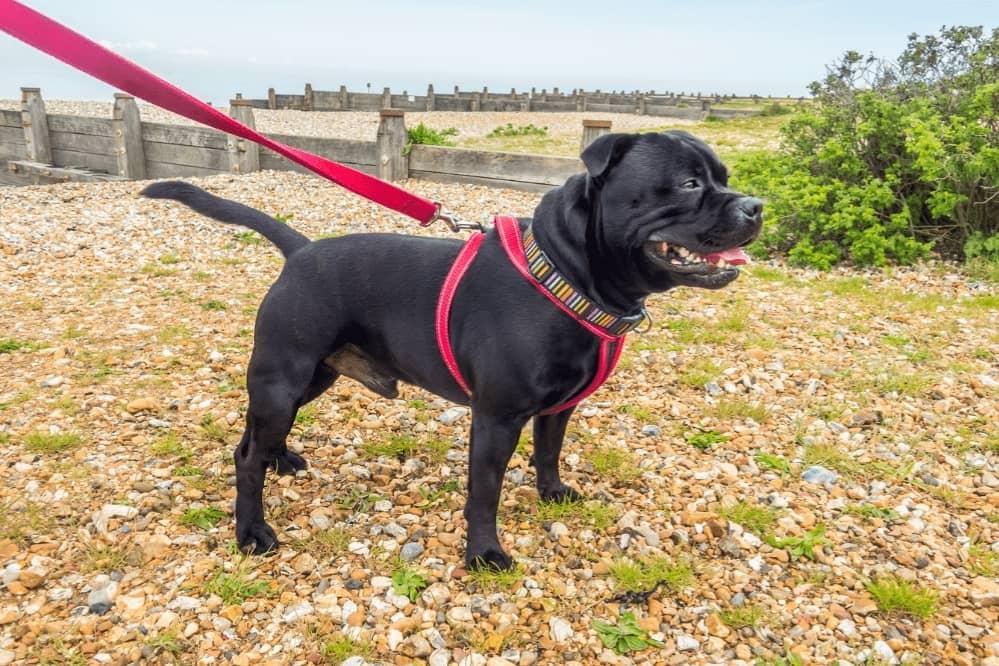One of the most common questions that dog owners ask about the training of their dogs, is how to stop the dog from pulling.
Every one of us has either experienced a dog that pulls or watched, possibly in amusement, as a dog takes their owner for a walk down along the sidewalk with the poor owner holding on for dear life to the leash behind them.
One way in which many dog owners think they can get their dog to stop pulling and walk calmly beside them is to change the dog from wearing a collar to wearing a harness.
This has its merits, but as you will discover in this article, it takes more than just changing what the dog’s leash is attached to change a dog’s behavior.
Pulling is What Dogs Do Instinctively
The simple truth is that such scenarios are not the fault of the dogs, as, after all, they are only doing what their instinct is telling them to do. Also, the fact that the dog’s owner has not corrected that behavior, nor trained their dog to walk correctly, is the owner’s responsibility, not the dog’s.
Pulling forward is the default position of most dogs unless they are taught not to. The reasons they pull forward include:
- Catching a new scent
- Investigating something new
- Seeing another dog
- Seeing other people
- Wanting to play
- Bursting with energy
- Their hunting instincts
These are the main ones, and with these, and more, there are plenty of reasons for your dog to want to pull forward. The problem is exacerbated because owners think that by pulling back on the leash, the dog is going to comply.
Unfortunately, the opposite is going to happen because the pressure that they feel causes them to instinctively pull against it. The term used for this by dog behaviorists is ‘opposition reflex.’
In effect, the dog thinks that the more they resist the pressure being applied to them, the closer they are getting to what they are trying to reach.
Dogs, and What They Sense
Dogs do things for one of two reasons: to enhance pleasure, or to avoid pain. The pain or pleasure does not need to be physical but can simply be how their owner is reacting to what they are doing.
Dogs are very intuitive and can sense when their owner is happy or angry with them. This can be due to the tone of voice the owner is using to praise or chastise them, or it can be in the body language their owner uses.
This also applies to the way in which they are being walked with regards to things like pressure on their neck or body, and how natural it feels to be walking in certain in relation to their owner.
It is these and other more subtle aspects of what a dog senses when they are walking that a harness can help with regards to stopping them pulling.
Praise and Non-Punishment
The mere fact of wearing a harness isn’t what changes a dog from one which pulls constantly, to one which walks beside you calmly. It will greatly rely on how you behave in relation to your dog’s behavior by praising them when they do well, and not praising them when they don’t.
You will note we didn’t say chastising your dog if they do wrong, as that often conjures up images of shouting at, or worse, hitting a dog if it misbehaves.
It doesn’t have to be like that, as merely withholding praise can alert a dog to the fact that they need to do things differently perhaps in the way that gets them the praise.
Ways a Harness Help You to Teach Your Dog to Stop Pulling
So, assuming you understand why your dog pulls and how it will react to your voice and movement, here are 5 ways a harness can help you with the aim of stopping them pulling.
More Points of Connection
With a harness, there are sometimes two connection points for leashes, and even if there is only one, the force applied from the owner is felt in more than a place by the dog and this diminishes their opposition reflex.
Less Pressure on Their Neck
Pulling while wearing a collar can cause a dog to lose his balance and they use the owner pulling back as a way of keeping that balance, which then becomes a tug of war between the two. With a harness, the pressure is off their neck and therefore they are less likely to lose balance.
Dog’s Position is More Natural
With a harness being worn by a dog, the leash attachment allows the owner to keep their dog in a more natural position by their side, rather than them pulling out in front.
It’s More Comfortable
For most dogs, wearing a harness, especially when walking and training, is more comfortable than a collar. This assumes the harness is the right size for them.
Better Communication Between Owner and Dog
Walking a dog in a harness means that any movement or adjustments made by the owner is more readily felt and understood by the dog, making them more inclined to comply, than resist.

